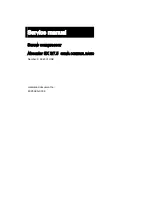
���
E
O
G
1
A
D
B
F
G
F
N
E
Pump Ranges
These operating instructions concern the following dry running rotary vane compressors: Models DLT 6 to DLT 40.
They have nominal capacities of 6, 10, 15, 25 and 40 m
3
/hr operating on 50 cycles. The pressure limits (bar) are indicated on the data plate (N).
The pumping curves showing capacity against pressure can be found in data sheet D 380.
Description
All models are complete with a pressure connection and a silencer on the inlet. All the air handled is filtered by a built-in micro-fine filter. Excess
carbon dust from the carbon blades is also filtered on the exhaust side by built-in filters. The compressor unit is encased in a rugged black plastic
sound enclosure. The cooling fan for the DLT is located inside the sound enclosure. On sizes 15, 25 and 40 with the larger motor the compressed
air is cooled by an aftercooler. Both the motor and compressor have a common shaft. Pressure can be adjusted to the required levels, however,
they are limited to a maximum point.
Optional extras (as required): Non return valve (ZRK), motor starter (ZMS) and pipe connection (ZSA).
Suitability
The units DLT are suitable for the use in the industrial field i.e. the protection equipments corresponds to EN DIN 294 table 4, for
people aged 14 and above.
The units DLT produce pressure up to the maximum limits, which are shown at the data plate (N). They may be operated continuously.
The ambient and suction temperatures must be between 5 and 40° C. For temperatures outside this range please contact your
supplier.
These dry running compressors are suitable for use with air of a relative humidy of 30 to 90%.
Dangerous mixtures (i.e. inflammable or explosive gases or vapours), extremely humid air, water vapour, aggressive gases or
traces of oil and grease must not be handled.
The standard versions may not be used in hazardous areas.
For all applications where an unplanned shut down of the compressor could possibly cause harm to persons or installations, a
corresponding safety backup system must be installed.
Handling and Setting up (pictures
���
and
���
)
There must be a minimum space of 30 cm in front of exhaust grid (G), suction grid (G
1
) and housing cover (b) for servicing. The cooling air
entries (E) and the cooling air exits (F) must have a minimum distance of 10 cm from any obstruction. The discharged cooling air must not be
re-circulated.
The DLT compressors can only be operated reliably if they are installed horizontally.
For installations that are higher than 1000 m above sea level there will be a loss in capacity. For further advice please contact your
supplier.
When the compressors are installed on a solid base, they do not need to be fixed down. If the compressors are installed on a base plate we would
recommend fitting anti-vibration mounts. This range of compressors are almost vibration free in operation.
Installation (picture
���
)
The compressors may not be operated without the standard pressure regulating and limiting valves fitted so that the maximum
pressure is not exceeded (see data plate).
For operating and installation follow any relevant national standards that are in operation.
1. Pressure connection at (B).
Long and/or small bore pipework should be avoided as this tends to reduce the capacity of the compressor.
2. The electrical data can be found on the data plate (N) or the motor data plate. The motors correspond to DIN/VDE 0530 and have IP 55
protection and insulation class F. The connection diagram can be found in the terminal box on the motor (unless a special plug connection is
fitted). Check the electrical data of the motor for compatibility with your available supply (voltage, frequency, permissible current etc.).
3. Connect the motor via motor starter. It is advisable to use thermal overload motor starters to protect the motor and wiring. All cabling used
on starters should be secured with good quality cable clamps.
We recommend that motor starters should be used that are fitted with a time delayed trip resulting from running beyond the amperage setting.
When the unit is started cold overamperage may occur for a short time.
The electrical installation may only be made by a qualified electrician under the observance of EN 60204. The main switch must
be provided by the operator.







































